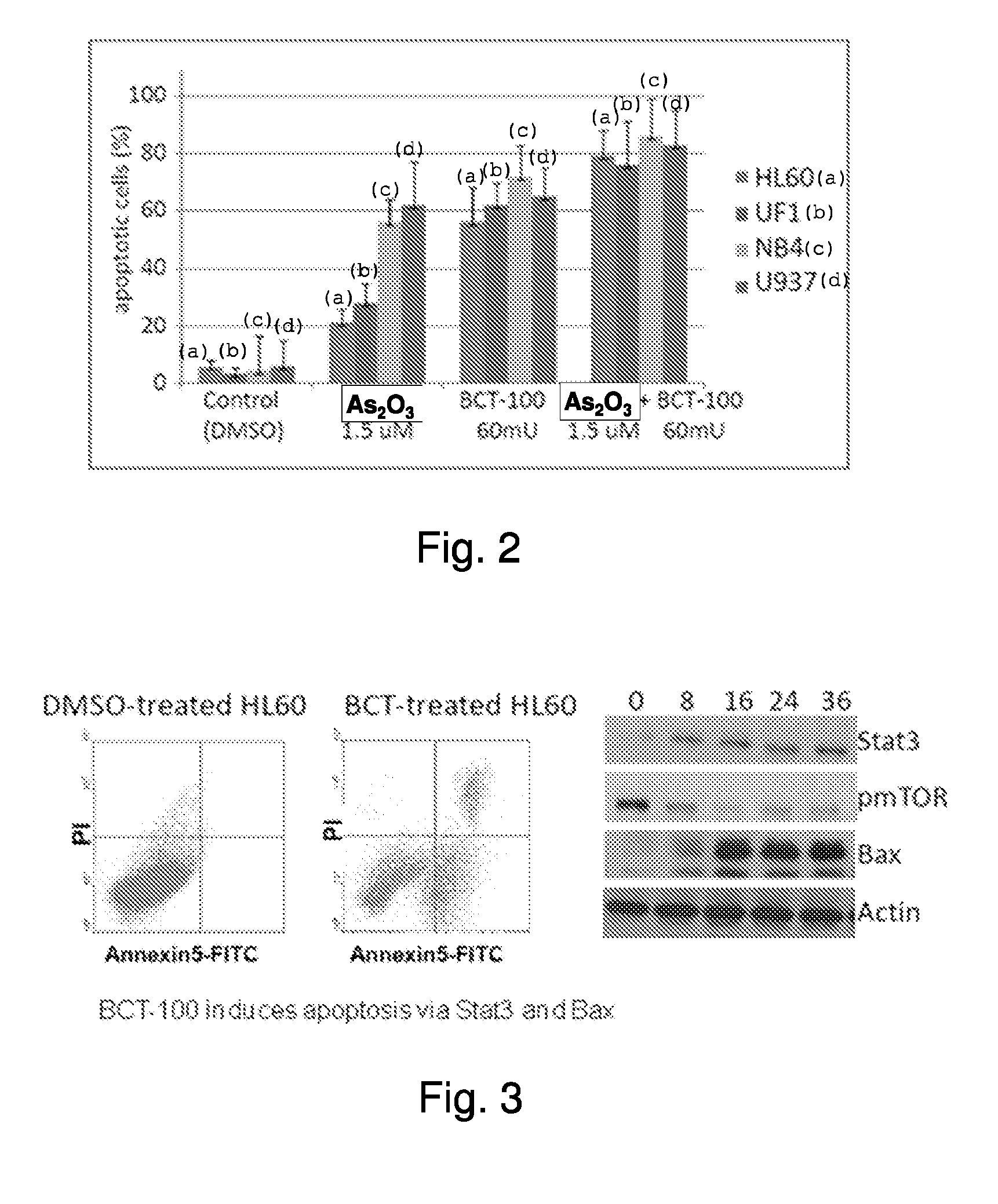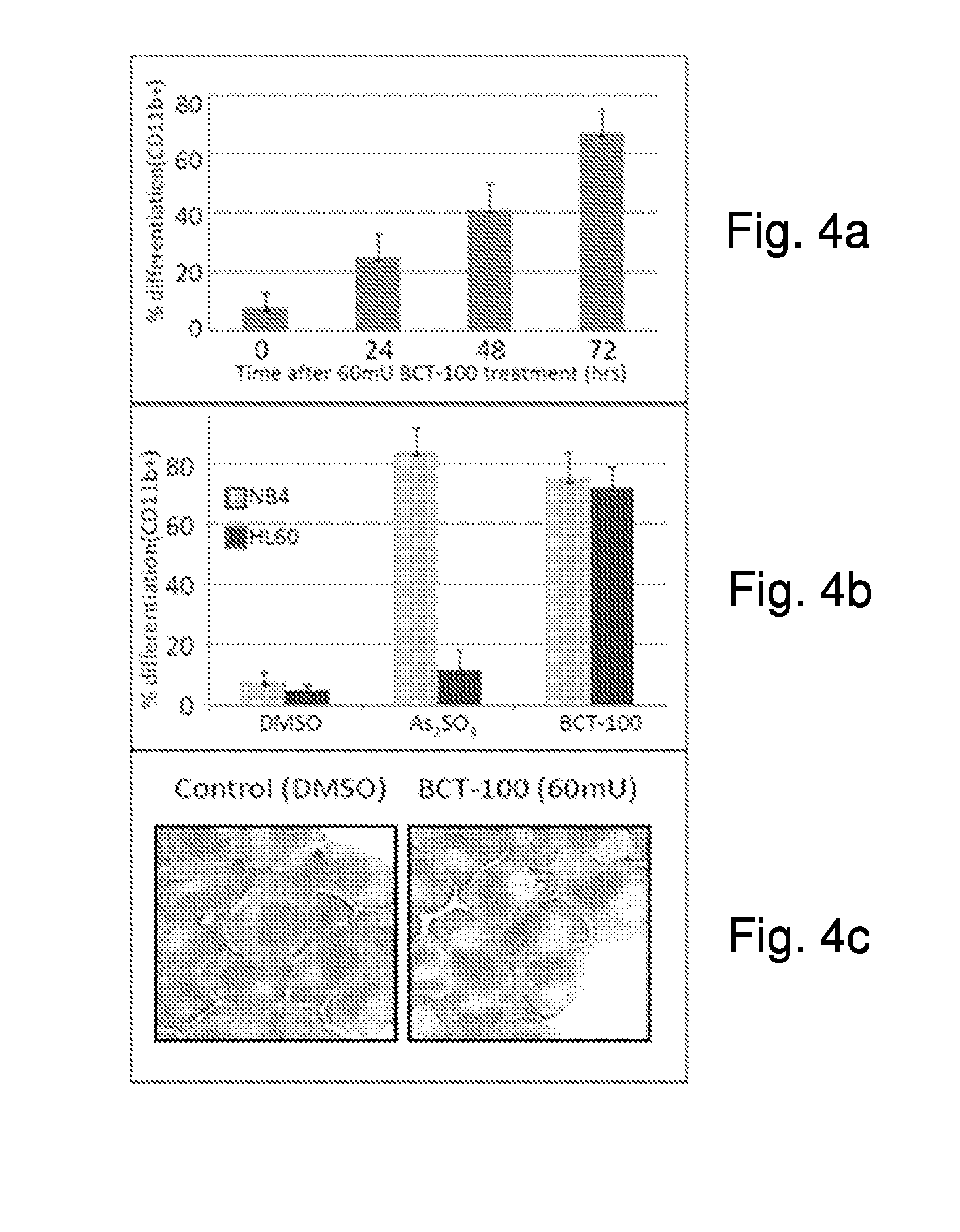Use of pegylated recombinant human arginase for treatment of leukemia
a technology of human arginase and pegylated recombinant, which is applied in the direction of organic active ingredients, drug compositions, peptide/protein ingredients, etc., can solve the problems of no standard treatment, high morbidity and modest treatment-related death, and the treatment can only be offered to patients with suitable human leukocyte antigen compatible donors, etc., to inhibit the growth of leukemia, increase the amount of bct-100, and reduce the effect o
- Summary
- Abstract
- Description
- Claims
- Application Information
AI Technical Summary
Benefits of technology
Problems solved by technology
Method used
Image
Examples
example 1
The Inhibitory Effect of BCT-100 on Various Leukemia Cell Lines
[0032]The inhibitory effect of BCT-100 in acute myeloid leukemia cells (Kasumi-1a, ML2, HL60, K562 and NB4) and T-cell leukemia cells (Jurkat, ALL-SIL, HPB-ALL and TALL-1) was studied. The IC50 values of BCT-100 in various cell lines are shown in Table 1. The result indicates that BCT-100 is effective in inhibiting the growth of leukemia, including myeloid leukemia and lymphocytic leukemic.
TABLE 1IC50 of BCT-100 in various leukemia cell lines.Myeloid LeukemiaIC50 (mU / mL)T-cell LeukemiaIC50 (mU / mL)Kasumi-1a65Jurkat40ML265All-SIL120HL6055HPB-ALL110K56225TALL-1100NB460
example 2
Effect of BCT-100 on Arsenic Sensitive and Arsenic Resistant Myelocytic Cell Lines
[0033]The effect of BCT-100 on arsenic sensitive myelocytic cell lines (NB4 and U937) as well as arsenic resistant myelocytic cell lines (HL60 and UF1) was investigated. FIG. 1a shows the effect of arsenic trioxide on cell viability in myelocytic leukemia cells. The cell viability in the arsenic sensitive NB4 and U937 cell lines dropped as the concentration of arsenic increased. However, HL60 and UF1 cell lines did not respond to As2O3 treatment.
[0034]FIG. 1b shows the effect of BCT-100 on cell viability in myelocytic leukemia cells NB4, U937, HL60 and UF1. Both the arsenic sensitive and resistant leukemia cells responded to the BCT-100 treatment. In all cases the cell viability dropped with increasing amount of BCT-100 in the medium.
[0035]The results showed BCT-100 is effective in inhibiting the growth of myelocytic leukemia, including myelocytic leukemia that is resistant to arsenic. Therefore, the a...
example 3
Effect of BCT-100 in Inducing Apoptosis in Leukemia Cells
[0036]The effect of BCT-100 in inducing apoptosis in both arsenic sensitive (NB4 and U937) and arsenic resistant (HL60 and UF1) leukemia cell lines was tested. As shown in FIG. 2, arsenic was effective in inducing apoptosis in leukemic cell lines NB4 and U937. However, the apoptosis rate was low in HL60 and UF1 cells in the presence of arsenic, as these cell lines are arsenic resistant. BCT-100 was found to be effective in inducing apoptosis in both arsenic sensitive and arsenic resistant leukemia cell lines. The apoptosis rate was further enhanced when BCT-100 is administrated in combination with arsenic trioxide.
PUM
| Property | Measurement | Unit |
|---|---|---|
| granulocytic morphology | aaaaa | aaaaa |
| concentration | aaaaa | aaaaa |
| fluorescence- | aaaaa | aaaaa |
Abstract
Description
Claims
Application Information
 Login to View More
Login to View More - R&D
- Intellectual Property
- Life Sciences
- Materials
- Tech Scout
- Unparalleled Data Quality
- Higher Quality Content
- 60% Fewer Hallucinations
Browse by: Latest US Patents, China's latest patents, Technical Efficacy Thesaurus, Application Domain, Technology Topic, Popular Technical Reports.
© 2025 PatSnap. All rights reserved.Legal|Privacy policy|Modern Slavery Act Transparency Statement|Sitemap|About US| Contact US: help@patsnap.com



